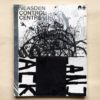TWS –Hi Jack, please tell us something you’d love people know about you.
I currently live in Tallahassee, Florida, with my fiancé and our two cats, Babette and Zooey. I enjoy playing tennis, reading, and listening to Steely Dan. I have been creating collages for about 8 years and am self-taught.
TWS –You have a degree in creative writing with a minor in art history. What led you to collage? How did you start making your art?
Even though I majored in creative writing, I’ve always been interested in art. In college, most of my friends were in art programs, so my connection to them and what they were studying flowed into a personal gravitation towards creating my own artwork at the end of college. Pursuing artwork offered me a new avenue for expression, which I appreciated after spending so many years studying just writing. When I first started making collages, I found the process incredibly rewarding and therapeutic; I really enjoyed creating something that didn’t necessarily have to do with strictly text. Working on a collage put me in a different mindset compared to working on a poem and gave me new perspectives on the environment around me.

TWS –Do you still write? If you do, what do you enjoy the most about writing?
Well, to be honest, I still write every now and again, but most of my energy is spent on collaging. I get to explore my initial passion of writing by helping run a creative writing class for kids, which is rewarding for me in a completely different way. One thing I really enjoy about writing is how personal it can be. I can read a poem or a story and get something out of it that isn’t necessarily what the author intended, or necessarily what other people took away, and I think that’s something that makes writing incredibly important and powerful. Of course, the same can be said about all forms of art (which has always been so fascinating to me).
TWS –Coming from the creative writing field, how do you feel about authors mixing literature and collage (Burroughs’ cut-ups and Oulipo’s literary games, etc.)? Do you make any creative writing with collage technique?
I’m so glad you referenced Burroughs, I’ve always appreciated his work. His cut-up technique helped bridge writing and art for me while I was in school. I’ve made a handful of cut-up poems, which encouraged me to view text and its possibilities differently. With this technique, I feel like I can physically manipulate words and make them my own, and I even incorporate this process into my collages.

TWS –Your work has evolved so much over time, managing to develop a personal style and approach to collage. Which are the main elements that you feel define your identity as an artist nowadays?
I really appreciate you saying that! Though I have noticed changes in my style and personal techniques over time, I definitely come back to certain themes and images. Image erasure and the blocking of main subjects is something I revisit frequently. And for one reason or another, I’ve found that I return to similar cutouts within my artwork, like images of frames, squares, hands, clothing, and text.
TWS –I can imagine your work is very physical. Can you walk us through your process?
My process is always changing but I mostly try to approach a collage with a vague idea of what I want, while being open to the end result. I’ve found it to be beneficial when I don’t allow myself to be boxed in while working on a piece. For me, it’s more enjoyable when a piece evolves into something I wasn’t fully expecting. Lately I’ve been using scotch tape as a way to erase parts of an image from a page. I do this by applying a small piece of tape to a section of a page, and ripping it off in short or long strips, leaving white space behind. This method tends to be unpredictable, but I think that’s something I enjoy most about this process.

TWS –There’s something about hiding and covering the main elements of images that’s key to defining your work. What’s the importance of image erasure in your art?
For me, by erasing parts of an image I gain a sense of control over the image itself. It creates the ability to turn it into something different. Working with found images, I think erasing or covering main parts of the image helps distance myself from the original meaning or implication. Image erasure gives the viewer room to move around and makes the piece feel more open. I’ve recently been working on this cartoon series where I cover up certain elements of the initial image by adding layers of paper to block out parts of the overall picture. This enables me to develop a texture while leaving a ghost of the image beneath.

TWS –Although you just use paper, sometimes it seems that you use papers to emulate brushstrokes, achieving visual pieces that have a reminiscence of expressionist paintings. How do you feel about this? Can you expand on this idea?
Being a self-taught artist with no formal art supplies, I wanted to see if I could do something with the collage materials I had on hand to create the appearance of painting. I really love expressionism and essentially, it immediately seeped into my work when I first started experimenting with this process. By either using tape to erase or paper to add, the collage gains that form of texture I like seeing in my work, similar to brush strokes. Movement is also something I’m fascinated in, and I think that’s something these false brushstrokes really achieve.


TWS –What’s your own and personal definition of collage?
Honestly, that’s such a loaded question. One thing I’ve learned about collage is that it is an all-encompassing genre. There is so much artwork that could be classified as collage and the definition could be a page long. A big aspect of collage, in my opinion, is the manipulation of an image. For me, the excitement and unknown element to collaging is through adding or removing components, ultimately creating a new meaning to found content and owning it. Trying to define the act of collaging or defining what a finished collaged product is, is just too great, but I know it when I see it.
Find more about Jack on his website or Instagram










